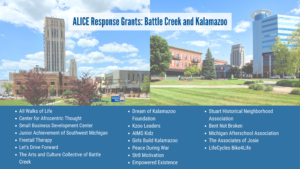Forty percent of households in Michigan, including more than 58,000 households in the Battle Creek and Kalamazoo region, can’t afford basic household necessities.
That sobering fact comes from the recently updated ALICE report, released today by the Michigan Association of United Ways.
“United Way is shining a light on the magnitude of ALICE – a complex challenge that no single organization can solve,” said Nancy Lindman, Interim CEO, Michigan Association of United Ways. “We are bringing communities together to help address conditions that will give households a chance to move above the ALICE threshold.”
ALICE, an acronym for Asset Limited, Income Constrained and Employed, includes people who are in poverty or just above the poverty level but struggling financially. To produce the United Way ALICE Report for Michigan, a national team of researchers collaborated with the Michigan Research Advisory Committee, composed of representatives from across the state, who advised and contributed to the report.
The report focuses on providing objective, comprehensive county-by-county data that identifies the size of the ALICE population in Michigan and works to identify the obstacles that keep these residents from achieving financial independence. The current report builds on data found in the 2014 ALICE study, showing not only continuity but also highlighting United Way’s commitment to this data.
Chris Sargent, Interim CEO of United Way of the Battle Creek and Kalamazoo Region (UWBCKR), said the new ALICE report puts a fine point on the organization’s regional work to help vulnerable individuals and families achieve financial stability.
“The vast majority of people we serve face financial hardship,” Sargent said. “Every one of our programs and partnerships in education, financial stability, health and basic needs aim to assist vulnerable individuals and families, especially those in or at risk of economic crisis.”
Sargent said households with limited income often exist in a state of financial stress, facing tough decisions to use what little money they have to pay rent, keep food on the table, keep the lights on, maintain a car to get to work or buy medicine to stay well. This can cause a spiral that can lead to a family losing a home, a person unable to work, or a child unable to learn in school.
“United Way strives for a vibrant community where all people realize their full potential. That means mobilizing the people, partners and resources needed to help every person succeed,” Sargent said. “The ALICE report gives us crucial data so we know where our efforts can deliver the greatest impact.”
Since August 2016, UWBCKR has announced $7,232,693 in single- and multi-year grants funding 130 programs with 71 partner agencies in the region. UWBCKR also partners in 32 additional community collaborations, such as BC Vision, the Learning Network of Kalamazoo, and the Homeless Coalition & ID Task Force. Find out more on our Partners & Programs page.
Below are links to the executive summary of the ALICE report, including pages on Calhoun and Kalamazoo counties, as well as the full report.
ALICE Report summary Michigan Calhoun County Kalamazoo County 2017










